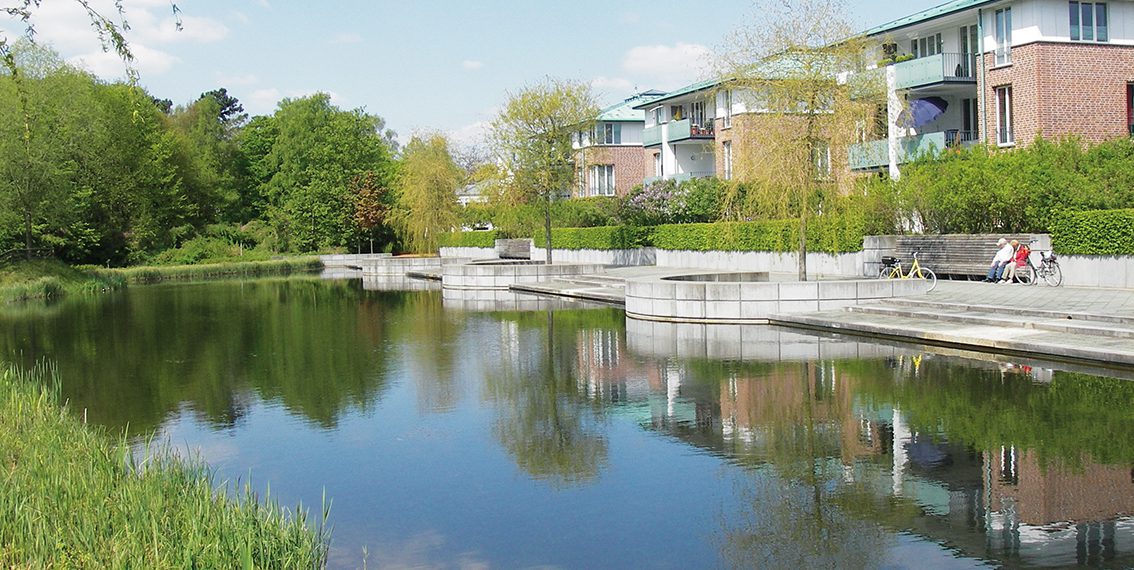Climate change poses a huge challenge for municipalities. Flooding due to heavy precipitation is becoming more frequent, while at the same time there is a threat of prolonged periods of heat and drought. Water plays a central role in the necessary adaptation to climate change, especially in urban areas. The creation of a natural water balance is just as much a focus as intelligent water management with a blue-green infrastructure. The storage of water on multifunctional surfaces, in infiltration systems and with green roofs and facades not only protects against flooding during heavy precipitation, but also secures the water supply for parks, street trees and inner-city green spaces during dry periods.
Evaporative cooling contributes significantly to mitigating heat stress. “Water and urban greenery are central building blocks of climate adaptation, for a healthy and livable urban landscape, and for the preservation and enhancement of biodiversity,” emphasized Prof. Uli Paetzel, President of the DWA German Association for Water, Wastewater and Waste, on the occasion of the presentation of the DWA position Water-conscious development of our cities.
Designing the cities of the future in a water-conscious way means a secure supply of high-quality and sufficient water, intensified greening as a heat and climate precaution and a management of precipitation water oriented to the natural water balance with blue-green infrastructure and multifunctional land use. The water-conscious city of the future cleverly combines the interests of water management, urban development, road and open space planning and climate protection in terms of function and design. Ecologically enhanced water bodies, banks and floodplains are part of an attractive urban landscape.
“Appropriate urban redevelopment measures are technically feasible, economically and ecologically beneficial, and legally possible.”
- Prof. Mathias Uhl, Chairman of the DWA Coordination Group “Water Aware City of the Future”
This has been demonstrated in numerous pilot projects throughout Germany. However, realization on a large scale often fails due to a lack of cooperation between potential project partners, legal uncertainties and fuzzy definitions of financial responsibilities.
One focus of the water-conscious city of the future is the natural water balance. Groundwater recharge and evaporation must be strengthened, and runoff from the city must be limited to levels typical of the landscape. Land-saving forms of development, water-permeable surfaces, infiltration systems, street and building greenery, cisterns, and retention ditches and basins are proven stormwater management measures and must be given greater consideration. Heavy rains and flood events require clearly identifiable emergency runoff paths in the terrain. In the future, green spaces, squares and sports facilities should be usable in a multifunctional manner, including for the short-term retention of stormwater runoff.
Small-scale and usable public water areas in parks and in streets or even small flowing bodies of water, wetlands simultaneously bring quality of stay, coolness and biodiversity to the cities. Rainwater and also hygienically safe wastewater treated for specific uses can be used as water resources for irrigation. Green roofs or facades, tree plantings, or water storage in open retention areas can reduce particulate matter and increase cooling through evaporation. Alternative water resources can be used to irrigate healthy vegetation with high evapotranspiration.
The appropriate measures are already possible on the basis of current law. The wastewater laws of the Federal Water Act and the state water laws give priority to decentralized precipitation water management. Most of the federal states have standardized concrete requirements for the permissibility or exemption from permission of precipitation water infiltration and authorized the municipalities to order decentralized precipitation water disposal. The German Building Code opens up far-reaching possibilities for planning urban green corridors, also for the purpose of water-conscious urban development, and for establishing the necessary green spaces and plantings in a binding manner with regard to new development, also as compensation for impact under nature conservation law. Urban development contracts offer extensive possibilities for regulating water-conscious design in large-scale projects.
Although the existing law already opens up many possibilities, it must be further optimized in the sense of a water-conscious city of the future. Among other things, a clear legal mandate for the development of decentralized precipitation management should be standardized in the Water Resources Act. In addition, the federal states should create water law options for (co-)financing heavy rainfall risk management. This possibility is not yet sufficiently provided for in the state water laws. In addition, sufficient financial resources must be made available both for the planning and construction of the corresponding blue-green infrastructure and for its long-term operation.

















